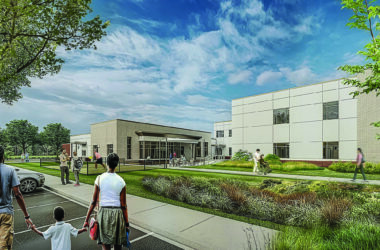
It’s a new year with the same focus: coronavirus and vaccinations.
County health officials are rolling with the punches as they work to coordinate vaccination distribution, and as long-term care facilities and workplaces continue to be at the center of coronavirus outbreaks locally.
With a county population of 378,879, as of Jan. 4, 4,332 people have been vaccinated, with zero having received both shots.
“There are currently about 4,300 individuals in Lane County vaccinated, according to the state tracking system,” said Jason Davis, public information officer for Lane County Health & Human Services. “However, there is a small complication in those numbers, as they are likely higher,” because local pharmacies do not record the immunizations in real-time and dump that information all at once.
Lane County pharmacies are primarily vaccinating long-term care facilities, working with those skilled nursing facilities primarily before moving on to the broader community, Davis said.
Jeannie Marr, owner of Creswell HealthMart Pharmacy, said that the pharmacy has been pre-approved to distribute the vaccine during the next phase, Phase 1B. “We are also working with the county to be a part of phases 1A and 1B … It’s a work in progress for sure,” Marr said.
Vaccination plans for the county are still fluid and ever-changing, but the public should be brought along in the process, even if things aren’t final, Davis said.
He said that in the past Lane County has undergone a large-scale vaccination effort both in H1N1 and a meningitis effort at the University of Oregon, in which the county had to look at vaccinating thousands of people in a short period of time.
Backing up to the start of the pandemic, “Our initial plans were really based around those efforts, and then the state came out with their plan. While we agree with the phased approach and the way that the state has designed that plan, it’s put the priority on the healthcare community and required us to go back and change our plans significantly,” Davis said.
There are multiple players at work. The federal government has been establishing contracts with pharmacies and vaccination sites, which has been hard for the county to track because the county primarily liaisons with the state. That effort is going on simultaneously with OHA as it works to distribute vaccines to local hospital groups.
OHA announced that it will be relaxing the sequencing for Phase 1A groups, which are primarily hospital staff, first responders and those who work in long-term care sites. Those people are divided up based on risk level – the number of sick patients they are exposed to, especially Covid patients – and then are broken into subgroups of primary care providers and other healthcare workers.
“What the state has effectively done is said to ‘relax’ that sequencing so everyone in that first group can be vaccinated … that is going to result in a faster vaccination effort for the healthcare community.”
As for the other groups, there is a possibility of mobile public health units, where public health would have a team that goes out to some of these groups, and is able to vaccinate them, Davis said.
“Governor Brown set a standard and is quite high. And so in order to achieve that, we’re going to need a multifaceted hybrid model where we have vaccinations happening at several different levels,” Davis said.
The question remains amongst a lot of people: How will I know when it’s my turn to get vaccinated?
Healthcare providers will be notified through their employer or through other health communication systems when they are able to get the vaccine.
The majority of the community – for those at-risk and essential workers – may get the vaccine through the public health mobile teams, or at closed-site vaccination events. For those vaccination events, public health would work with a specific industry at a centralized location specifically for those employers.
“This is going to be somewhat in the future, but we will be utilizing mass media to message out as well as direct communication through employers as much as possible where we have direct lines,” Davis said.
As far as the general population, “we already have plans in place for mass vaccination so these will be large scale, potentially drive-thru events where individuals are able to quickly and efficiently receive their first dose of the vaccine,” Davis said.
Public health will let you know weeks in advance, Davis said. “But currently, we are still in that very first stage of trying to get our healthcare community vaccinated and the state is working directly with the hospital groups to do that.”
Vaccination distribution starts off on the federal level, then goes down to the state level, then to the county. The county has not received any vaccinations to date.
“The county is unfortunately at the receiving end, but you can rest assured that Lane County will be ready for action as soon as we have vaccines available in large doses for the general public, and we will have and we have our plans in place to be able to distribute that.
“We are not there yet,” Davis said. There is no date or deadline for these distributions. “If we have learned anything about the way COVID works and the way the response to COVID works. It is a changing process, and it can dramatically look different from day-to-day.”
Testing & outbreaks
Testing slowed down considerably over the holidays due to staffing, Davis said, and expects higher rates of positivity with more tests in incoming weeks. As of Jan. 5, Springfield reports 2,072 cases; Cottage Grove with 228; Creswell with 191; and Pleasant Hill with 40 cases.
Lane County has 7,290 cases, with 35 hospitalizations and six of those people in the ICU. “Just looking at those two figures, that is somewhat encouraging,” Davis said, because the daily downtread of cases is lower compared to other days.
“Our hospitalizations at only 35, and while that is an increase of a few since yesterday, it’s still well within the manageable reach. As we get to 2021, there is reason to be hopeful in terms of our cases,” Davis said.
Long-term facilities and workplaces continue to be hotspots for the virus.
The county has 52 active outbreaks, with 839 of those cases associated with those outbreaks – with 70% of those numbers coming from long-term care facilities.
Creswell Health and Rehabilitation Center first reported an outbreak on Oct. 31 and has since had 51 positive cases with one death. Since December, Spring Living Assisted Living Facility has reported 15 cases and three deaths; McKenzie Living Facility reported six cases and zero deaths; The Rawlin at RiverBend Memory Care has reported 19 cases and one death; and the Marquis Springfield Post Acute Rehab facility reported 14 cases and zero deaths.
Davis said the county has seen its first case of a duel-infected person with influenza and the coronavirus, and several influenza cases pop up at several long-term care facilities.
Because of the protocols in place for COVID-19, the county is reportedly at low-risk for influenza but nonetheless, “if we’re looking at a cocktail of covid-influenza, that can really spell disaster, especially for those individuals where we’re seeing the most cases for long-term care facilities,” Davis said that influenza cases are not tracked the same way as coronavirus cases, so the county does not have “real-time testing,” like we do with COVID-19.
Following long-term facilities, about 22% of outbreaks are reported from workplaces, like McKenzie-Willamette Medical Center, which reported 33 cases in December and Rosboro Co. LLC in Springfield, which reported 13 cases.
About 4% of the cases are tied to religious activities or religious facilities activities associated with its facilities. “This is kind of a small number, and essentially is one or two different outbreaks, so it’s not necessarily that we’re seeing a rash of cases tied to those faith-based activities. It’s more that we have a relatively small sample size that has accounted for a number of cases.”
Davis said that in a positive twist, social gathering outbreaks have “dropped down virtually to none.” Same goes for child-care facilities, though Davis attributes the decrease due to at-home child care during the holidays. “But still, that’s good news,” he said.







